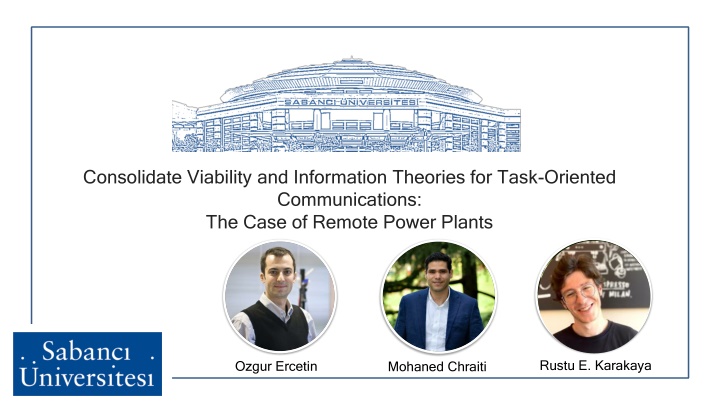
Unveiling Viability Theory for Task-Oriented Communications
This study delves into the application of Viability Theory in task-oriented communications, focusing on remote power plants. It explores the core idea of assessing communication rates for system operations, contrasting it with traditional optimization methods. The concept of Viability Space, Viable Space, and Viability Kernel is examined, highlighting their significance in ensuring system reliability and safety. The comparison between Viability Theory and Semantic Communications is illustrated through practical examples in autonomous vehicle scenarios.
Download Presentation

Please find below an Image/Link to download the presentation.
The content on the website is provided AS IS for your information and personal use only. It may not be sold, licensed, or shared on other websites without obtaining consent from the author. If you encounter any issues during the download, it is possible that the publisher has removed the file from their server.
You are allowed to download the files provided on this website for personal or commercial use, subject to the condition that they are used lawfully. All files are the property of their respective owners.
The content on the website is provided AS IS for your information and personal use only. It may not be sold, licensed, or shared on other websites without obtaining consent from the author.
E N D
Presentation Transcript
Consolidate Viability and Information Theories for Task-Oriented Communications: The Case of Remote Power Plants Rustu E. Karakaya Ozgur Ercetin Mohaned Chraiti
Outline Results Power plant: ToC Viability theory for ToC System model Problem Formulation Simulations Conclusions ToC vs Semantic comm. Viability theory Transfer entropy 2
Viability Theory for ToC Task-oriented vs Semantic Communications ToC: Final action (stop the vehicle) Semantic: - types - number - Shapes Presence of an obstacle at X meters The integrity of data Counter intuitive example: - Red light: a tree is in the road - Green light: the tree is removed from the road Example: Autonomous vehicle assisted by a control unit in the cloud 3
Viability Theory for ToC Core idea Core idea Develop a general framework to assess the minimum communication rate that ensures proper operations of the system It is deemed to be difficult to incorporate unforeseen events while using exiting optimization principle Risk assessment is implicit while applying the viability theory Viability space can be determined through optimization, machine learning or other tools, but differs in concept to typical optimization Viability theory concept: Through the longest path there is a larger room for errors larger viable space Typical optimization concept: Shortest path one solution as per the objective function 4
Viability Theory for ToC Viability space Viable space K: The space of the states in which the constraints (including the safety) are fulfilled Viability Kernel: The space of the states from which the system starts and remains while evolving within the viable space (avoid dead ends) Non-viable space: the space of the possible states where one or multiple constraints are not satisfied The closer is the state to the center of the kernel, the lowest is the probability to be propelled into a non-viable state given an unforeseen event 5
Viability Theory for ToC Size of the viability kernel: communication rate, environment and system capability Communication channel Control/assistance unit: - Trained model - Chirurgical precision Actor: Initially Less knowledgeable than the control unit Environment Viability kernel by analogy to the probability distribution Viability kernel by analogy to the probability distribution Case 1: high communication rate Case 2: low communication rate Pr ? ? ????? Pr ? ? ????? 6
Viability Theory for ToC Transfer Entropy : knowledge transfer Core idea The capacity of the actor to learn from the decisions of the control unit and vice versa are often overlooked to reduce the communication rate Actor Transfer Entropy: quantifies the flow of information between two random processes by analyzing causality The impact of the control unit decisions/directives at the previous (N 1) time slots on the state of the actor is quantified as follows: Flow of information between two random processes ????(? + 1)? =1 ??(?(??)|? ?? ,? ?? ? ? 1 ,? ?? ? ,? ?? 2? , ) +1 ?DI (? ?? ,? ?? ? , ? ?? ,? ?? 2? ) Control/assistance unit 7
Power plant: ToC System model System model Power Plant: it is one of the basic system often studied in dynamic control theory Sate variables: temperature and pressure Power plant Control inputs: the rate at which the heat is supplied to the plant and the rate at which a pneumatic piston is displaced Objective: adjust the communication rate to keep the state variables within the viability kernel Communication and information flow The process requires cycling the plant repeatedly through three operating points (normalized numerical values): X1 = (0, 0), X2 = (2.5, 2), and X3 = (1, 3) (neighborhoods) Control unit the system must visit three states levels cyclically in order 8
Power plant: ToC Mathematical formulation ? (?+1)? ?????? ?( ? + 1 ?) ????( ? + 1 ?) inf where the in-the-loop transfer entropy is given by ????(? + 1)? =1 ??(?(??)|? ?? ,? ?? ? ? 1 ,? ?? ? ,? ?? 2? , ) +1 ?DI (? ?? ,? ?? ? , ? ?? ,? ?? 2? ) 9
Coherence Time/Sapce Simulation results: example in [9] Evolution of the communication rate with time and its impact on the state of the system at phase-I The proposed solution decrease the communication rate by 50% in Phase, by 12% in Phase-III, and by 14% in Phase-III 10
Conclusions Incorporate the viability theory and directed information reduce the communication rate from ToC perspective Proposes a ToC framework to implicitly quantify unforeseen events Demonstrates the integration of viability theory into TOC with an academic example of power plant system 11
